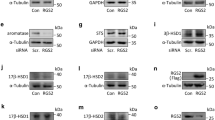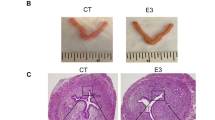Abstract
Although it has been suggested that the transcription of phospholipid hydroperoxide glutathione peroxidase (PHGPx), an essential antioxidant selenoenzyme, may be affected by the estrogen state in mammals, the direct mechanism underlying the regulation of the PHGPx gene by estrogens in mammalian tissues remains to be clearly elucidated. In this study, we evaluated the expression of the PHGPx mRNA in cultured mouse fetuses (embryonic days 8.5–10.5) exposed to 17β-estradiol (E2; 0.1, 1, 10, 100, and 1,000 ng/ml); estrogen receptor (ER) agonists [propyl pyrazole triol (PPT, an ERα-selective ligand, 1 μl/ml) and diarylpropionitrile (DPN, an ERβ-selective ligand, 1 μl/ml)]; and/or ER antagonist [ICI 182,780 (ICI, 1 μl/ml)] using a whole embryo culture system. E2-alone treatment significantly stimulated the expressions of both ERα and ERβ mRNAs in all the cultured fetuses (p < 0.05), although the ERβ mRNA levels were higher than ERα mRNA. PHGPx mRNA expression was significantly increased in all the fetuses treated with E2 (1–1,000 ng/ml), PPT, and DPN (p < 0.05). Furthermore, pretreatment with ICI completely blocked the E2-induced PHGPx mRNA expression in the fetuses. In addition, the mRNA levels of cytosolic GPx, the other intracellular antioxidant selenoenzyme, did not differ significantly from the controls by an exposure to those agents. These results suggest that the PHGPx gene is regulated via an estrogen and ER signal pathway in the cultured mouse fetus.




Similar content being viewed by others
References
An J.; Ribeiro R. C.; Webb P.; Gustafsson J. A.; Kushner P. J.; Baxter J. D.; Leitman D. C. Estradiol repression of tumor necrosis factor-alpha transcription requires estrogen receptor activation function-2 and is enhanced by coactivators. Proc. Natl. Acad. Sci. USA 96: 15161–15166; 1999.
Baek I. J.; Seo D. S.; Yon J. M.; Lee S. R.; Jin Y.; Nahm S. S.; Jeong J. H.; Choo Y. K.; Kang J. K.; Lee B. J.; Yun Y. W.; Nam S. Y. Tissue expression and cellular localization of phospholipid hydroperoxide glutathione peroxidase (PHGPx) mRNA in male mice. J. Mol. Histol. 38: 237–244; 2007a.
Baek I. J.; Yon J. M.; Lee S. R.; Jin Y.; Kim M. R.; Ahn B.; Hong J. T.; Choo Y. K.; Lee B. J.; Yun Y. W.; Nam S. Y. Effects of endocrine disrupting chemicals on expression of phospholipid hydroperoxide glutathione peroxidase mRNA in rat testes. J. Vet. Sci. 8(3): 213–218; 2007b.
Beato M.; Herrlich P.; Schutz G. Steroid hormone receptors: many actors in search of a plot. Cell 83: 851–857; 1995.
Borchert A.; Schnurr K.; Thiele B. J.; Kuhn H. Cloning of the mouse phospholipid hydroperoxide glutathione peroxidase gene. FEBS Lett. 446: 223–227; 1999.
Brigelius-Flohe R.; Aumann K. D.; Blocker H.; Gross G.; Kiess M.; Kloppel K. D.; Maiorino M.; Roveri A.; Schuckelt R.; Usani F. Phospholipid hydroperoxide glutathione peroxidase. Genomic DNA, cDNA, and deduced amino acid sequence. J. Biol. Chem. 269: 7342–7348; 1994.
Imai H.; Hirao F.; Sakamoto T.; Sekine K.; Mizukura Y.; Saito M.; Kitamoto T.; Hayasaka M.; Hanaoka K.; Nakagawa Y. Early embryonic lethality caused by targeted disruption of the mouse PHGPx gene. Biochem. Biophys. Res. Commun. 305: 278–286; 2003.
Imai H.; Nakagawa Y. Biological significance of phospholipid hydroperoxide glutathione peroxidase (PHGPx, GPx4) in mammalian cells. Free Radic. Biol. Med. 34: 145–169; 2003.
Kim M. R.; Lee K. N.; Yon J. M.; Lee S. R.; Jin Y.; Baek I. J.; Lee B. J.; Yun Y. W.; Nam S. Y. Capsaicin prevents ethanol-induced teratogenicity in cultured mouse whole embryos. Reprod. Toxicol. 26(3–4): 292–297; 2008.
Kraichely D. M.; Sun J.; Katzenellenbogen J. A.; Katzenellenbogen B. S. Conformational changes and coactivator recruitment by novel ligands for estrogen receptor-alpha and estrogen receptor-beta: correlations with biological character and distinct differences among SRC coactivator family members. Endocrinology 141: 3534–3545; 2000.
Kuiper G. G.; Carlsson B.; Grandien K.; Enmark E.; Haggblad J.; Nilsson S.; Gustafsson J. A. Comparison of the ligand binding specificity and transcript tissue distribution of estrogen receptors alpha and beta. Endocrinology 138: 863–870; 1997.
Kuiper G. G.; Gustafsson J. A. The novel estrogen receptor-beta subtype: potential role in the cell- and promoter-specific actions of estrogens and anti-estrogens. FEBS Lett. 410: 87–90; 1997.
Lapointe J.; Kimmins S.; Maclaren L. A.; Bilodeau J. F. Estrogen selectively up-regulates the phospholipid hydroperoxide glutathione peroxidase in the oviducts. Endocrinology 146: 2583–2592; 2005.
Lee B. J.; Jung E. Y.; Yun Y. W.; Kang J. K.; Baek I. J.; Yon J. M.; Lee Y. B.; Sohn H. S.; Lee J. Y.; Kim K. S.; Nam S. Y. Effects of exposure to genistein during pubertal development on the reproductive system of male mice. J. Reprod. Dev. 50: 399–409; 2004.
Livak K. J.; Schmittgen T. D. Analysis of relative gene expression data using real-time quantitative PCR and the 2(−delta delta C(T)) method. Methods 25: 402–408; 2001.
Meyers M. J.; Sun J.; Carlson K. E.; Marriner G. A.; Katzenellenbogen B. S.; Katzenellenbogen J. A. Estrogen receptor-beta potency-selective ligands: structure–activity relationship studies of diarylpropionitriles and their acetylene and polar analogues. J. Med. Chem. 44: 4230–4251; 2001.
Nam S. Y.; Baek I. J.; Lee B. J.; In C. H.; Jung E. Y.; Yon J. M.; Ahn B.; Kang J. K.; Yu W. J.; Yun Y. W. Effects of 17beta-estradiol and tamoxifen on the selenoprotein phospholipid hydroperoxide glutathione peroxidase (PHGPx) mRNA expression in male reproductive organs of rats. J. Reprod. Dev. 49: 389–396; 2003.
New D. A. Whole-embryo culture and the study of mammalian embryos during organogenesis. Biol. Rev. Camb. Philos. Soc. 53: 81–122; 1978.
Pettersson K.; Grandien K.; Kuiper G. G.; Gustafsson J. A. Mouse estrogen receptor beta forms estrogen response element-binding heterodimers with estrogen receptor alpha. Mol. Endocrinol. 11(10): 1486–1496; 1997.
Roveri A.; Casasco A.; Maiorino M.; Dalan P.; Calligaro A.; Ursini F. Phospholipid hydroperoxide glutathione peroxidase of rat testis. Gonadotropin dependence and immunocytochemical identification. J. Biol. Chem. 267: 6142–6146; 1992.
Schneider M.; Vogt Weisenhorn D. M.; Seiler A.; Bornkamm G. W.; Brielmeier M.; Conrad M. Embryonic expression profile of phospholipid hydroperoxide glutathione peroxidase. Gene Expr. Pattern 6: 489–494; 2006.
Stauffer S. R.; Coletta C. J.; Tedesco R.; Nishiguchi G.; Carlson K.; Sun J.; Katzenellenbogen B. S.; Katzenellenbogen J. A. Pyrazole ligands: structure-affinity/activity relationships and estrogen receptor-alpha-selective agonists. J. Med. Chem. 43(26): 4934–4947; 2000.
Tsai M. J.; O’Malley B. W. Molecular mechanisms of action of steroid/thyroid receptor superfamily members. Annu. Rev. Biochem. 63: 451–486; 1994.
Yagi K.; Komura S.; Kojima H.; Sun Q.; Nagata N.; Ohishi N.; Nishikimi M. Expression of human phospholipid hydroperoxide glutathione peroxidase gene for protection of host cells from lipid hydroperoxide-mediated injury. Biochem. Biophys. Res. Commun. 219: 486–491; 1996.
Yant L. J.; Ran Q.; Rao L.; Van Remmen H.; Shibatani T.; Belter J. G.; Motta L.; Richardson A.; Prolla T. A. The selenoprotein GPX4 is essential for mouse development and protects from radiation and oxidative damage insults. Free Radic. Biol. Med. 34: 496–502; 2003.
Zhang L.; Fujii S.; Kosaka H. Effect of oestrogen on reactive oxygen species production in the aortas of ovariectomized Dahl salt-sensitive rats. J. Hypertens. 25(2): 407–414; 2007.
Acknowledgments
This work was supported by Priority Research Centers Program through the National Research Foundation of Korea (NRF) funded by the Ministry of Education, Science and Technology (2010-0029709) and Korea Research Foundation Grant funded by the Korean Government (KRF-2008-357-E00069).
Author information
Authors and Affiliations
Corresponding author
Additional information
Editor: T. Okamoto
Rights and permissions
About this article
Cite this article
Baek, IJ., Jung, K.Y., Yon, JM. et al. Phospholipid hydroperoxide glutathione peroxidase gene is regulated via an estrogen and estrogen receptor signaling in cultured mouse fetuses. In Vitro Cell.Dev.Biol.-Animal 47, 535–540 (2011). https://doi.org/10.1007/s11626-011-9438-z
Received:
Accepted:
Published:
Issue Date:
DOI: https://doi.org/10.1007/s11626-011-9438-z




